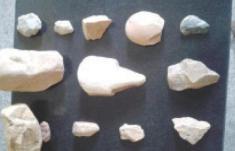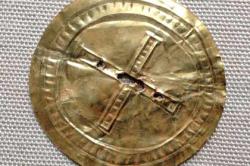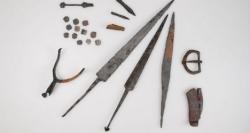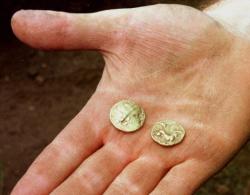INSTITUT SUPERIEUR D'ANTHROPOLOGIE
INSTITUTE OF ANTHROPOLOGY
ONLINE COURSES / COURS A DISTANCE
FALL TERM : OCTOBER 2015
REGISTER NOW
USA –  Bacon's Castle - Few stretches of American soil have been probed as much as the yards at Bacon's Castle, the landmark 1665 house that ranks as the nation's oldest surviving brick dwelling. Yet even after that remarkable find — which measured larger than a football field — the ancient property surrounding what was long known as Allen's Brick House was far from done coughing up subterranean surprises. That's what happened in mid-May when Preservation Virginia restoration craftsman Mike Adams began work on a new handicapped parking spot located some 20 paces east of the house's mid-1800s addition. Digging less than 6 inches down, he started hitting old brick and mortar laden with bits of oyster shell, then the U-shaped outline of a massive fireplace measuring more than 10 feet long. That was followed by a second, equally immense firebox that butted back against the first and faced the other direction. "What you see is an extraordinarily large, H-shaped chimney base," says archaeologist Nick Luccketti, head of the James River Institute for Archaeology, which was called in to study and document the unexpected find. "This was a very substantial building. It probably combined the function of a kitchen with that of a laundry or a brewery. And it dates back to the late 1600s or early 1700s, when Arthur Allen II was reshaping the landscape here to reflect his status as one of the most powerful men in Virginia."
Bacon's Castle - Few stretches of American soil have been probed as much as the yards at Bacon's Castle, the landmark 1665 house that ranks as the nation's oldest surviving brick dwelling. Yet even after that remarkable find — which measured larger than a football field — the ancient property surrounding what was long known as Allen's Brick House was far from done coughing up subterranean surprises. That's what happened in mid-May when Preservation Virginia restoration craftsman Mike Adams began work on a new handicapped parking spot located some 20 paces east of the house's mid-1800s addition. Digging less than 6 inches down, he started hitting old brick and mortar laden with bits of oyster shell, then the U-shaped outline of a massive fireplace measuring more than 10 feet long. That was followed by a second, equally immense firebox that butted back against the first and faced the other direction. "What you see is an extraordinarily large, H-shaped chimney base," says archaeologist Nick Luccketti, head of the James River Institute for Archaeology, which was called in to study and document the unexpected find. "This was a very substantial building. It probably combined the function of a kitchen with that of a laundry or a brewery. And it dates back to the late 1600s or early 1700s, when Arthur Allen II was reshaping the landscape here to reflect his status as one of the most powerful men in Virginia."
http://www.dailypress.com/features/history/dp-nws-bacons-castle-archaeology-20150618-story.html
INDE –  Talcher - The discovery of several Stone Age weapons along Brahmani river near Odisha’s Talcher town has enthused historians and archaeologists alike. Local collectors came across these ancient weapons along the Brahmani river bringing back archaeological spotlight on the area of possible human civilisation in the region. Historians are of the view that a human civilisation existed in Talcher as ancient articles were discovered from Kankili, Dharampur, Gurujanga and Samal on the outskirts of Talcher earlier also. Manoj Kumar Mohapatra, a Talcher-based collector, along with some students of Archaeology department and local people, was engaged in research along the Brahmani river since last two months. The members of the research team discovered several weapons used by humans from Kankili, Dharampur, Gurujanga, Jandabahal and Samal which are along the Brahmani river. They found four handmade axes, 18 cutting tools, choppers, scaling instruments, seven chisels and carpenter’s axes. The discovery of ancient articles is not new for Talcher. In 1875, Valentine Ball had discovered pre-historic antiquities from Kaliakata village under Nisa panchayat under Chhendipada block.
Talcher - The discovery of several Stone Age weapons along Brahmani river near Odisha’s Talcher town has enthused historians and archaeologists alike. Local collectors came across these ancient weapons along the Brahmani river bringing back archaeological spotlight on the area of possible human civilisation in the region. Historians are of the view that a human civilisation existed in Talcher as ancient articles were discovered from Kankili, Dharampur, Gurujanga and Samal on the outskirts of Talcher earlier also. Manoj Kumar Mohapatra, a Talcher-based collector, along with some students of Archaeology department and local people, was engaged in research along the Brahmani river since last two months. The members of the research team discovered several weapons used by humans from Kankili, Dharampur, Gurujanga, Jandabahal and Samal which are along the Brahmani river. They found four handmade axes, 18 cutting tools, choppers, scaling instruments, seven chisels and carpenter’s axes. The discovery of ancient articles is not new for Talcher. In 1875, Valentine Ball had discovered pre-historic antiquities from Kaliakata village under Nisa panchayat under Chhendipada block.
http://odishasuntimes.com/132873/stone-age-weapons-discovered-along-brahmani-river-in-odisha/
ROYAUME UNI –  Monkton Farleigh - Marking this year’s summer solstice an early Bronze Age sun-disc, one of the earliest metal objects found in Britain, has gone on display for the first time at Wiltshire Museum. Archaeologists believe the disc was forged in about 2,400 BC, soon after the great sarsen stones were put up at Stonehenge. It is thought it was worn on clothing to represent the sun. The sun-disc, one of only six such finds, was discovered in a burial mound at Monkton Farleigh, just 20 miles from Stonehenge. It was found during excavations by Guy Underwood in 1947 along with a pottery beaker, flint arrowheads and fragments of the skeleton of an adult male.
Monkton Farleigh - Marking this year’s summer solstice an early Bronze Age sun-disc, one of the earliest metal objects found in Britain, has gone on display for the first time at Wiltshire Museum. Archaeologists believe the disc was forged in about 2,400 BC, soon after the great sarsen stones were put up at Stonehenge. It is thought it was worn on clothing to represent the sun. The sun-disc, one of only six such finds, was discovered in a burial mound at Monkton Farleigh, just 20 miles from Stonehenge. It was found during excavations by Guy Underwood in 1947 along with a pottery beaker, flint arrowheads and fragments of the skeleton of an adult male.
http://www.culture24.org.uk/history-and-heritage/archaeology/art529786-stonehenge-sun-disc-from-the-dawn-of-history-goes-on-display-in-wiltshire-for-summer-solstice
CHINE – Taosi - The excavation of Taosi began in 1978 and over the years archaeologists have unearthed relics that point to a functioning society, including large tombs, copperware and porcelain. Wang says that this disproves sceptics' theories that Yao was not real. "The site has the earliest kingdom relics we've found in the middle reaches of the Yellow River. Yao was one of the sage emperors living in the area. We believe Taosi is the empire's capital," he is quoted by China.org as saying. "Palaces, royal tombs, ceremonial buildings and storage areas, as well as fortifications such as high walls and moats, could indicate a capital settlement. "Taosi is what some historical materials identify as Pingyang, the capital of the Yao regime. Our studies proved that Emperor Yao is not just a legend, but a true story." Hu Suping, director of the Publicity Department of Shanxi province, added: "Years of archaeological studies gave the world a close look at the history and also made legends into reality. "The Chinese culture has a long history, and archaeology gives more people a chance to explore the past for a better look into the future"
http://www.ibtimes.co.uk/ancient-china-researchers-unearth-emperor-yaos-capital-city-1506978
FRANCE – Normandie - British researchers on Monday began collecting the DNA of residents from Normandy in northern France in search of Viking heritage. Around a hundred volunteers from the Cotentin Peninsula area are giving DNA samples to academics at the University of Leicester, who are trying to find descendants of the Vikings who invaded what is now Normandy in the 9th century. The aim is to learn more about "the intensity of the Scandinavian colonisation" in the 9th and 10th centuries in the Cotentin Peninsula, said Richard Jones, a senior history lecturer at the University of Leicester. That includes trying to find out whether the colonisers kept to themselves or married amongst the locals, he added. The French volunteers have been chosen because they have surnames that are of Scandinavian origin or that have been present in France since at least the 11th century. They also qualify if all four of their grandparents lived within a 50-kilometre (30-mile) radius of their current home. French data protection authorities gave their green light to the study, which will be published in 2016
http://phys.org/news/2015-06-british-scientists-viking-norman-dna.html
SUISSE –  Morgarten - Archeologists have found 14th century artifacts on what could be the site of the Battle of Morgarten, when soldiers of the Swiss confederacy ambushed Austrian soldiers in a victory that consolidated the nascent nation of Switzerland 700 years ago. In what is being hailed as a significant discovery, the find includes coins, knives, arrows and a cavalier’s spur in the Morgarten plain on the border of the cantons of Schwyz and Zug, the SDA news agency reported on Thursday. Among the objects found are 12 silver coins — Pfennigs — dating from 1275 to the start of the 14th century, which would be consistent with the 1315 battle date. Various arms dating from the 14th century were also found, including two knives, a knife scabbard and two arrows from a crossbow or bow. Other items, including knives and horse shoes were more difficult to date.
Morgarten - Archeologists have found 14th century artifacts on what could be the site of the Battle of Morgarten, when soldiers of the Swiss confederacy ambushed Austrian soldiers in a victory that consolidated the nascent nation of Switzerland 700 years ago. In what is being hailed as a significant discovery, the find includes coins, knives, arrows and a cavalier’s spur in the Morgarten plain on the border of the cantons of Schwyz and Zug, the SDA news agency reported on Thursday. Among the objects found are 12 silver coins — Pfennigs — dating from 1275 to the start of the 14th century, which would be consistent with the 1315 battle date. Various arms dating from the 14th century were also found, including two knives, a knife scabbard and two arrows from a crossbow or bow. Other items, including knives and horse shoes were more difficult to date.
http://www.thelocal.ch/20150619/artifacts-found-on-700-year-old-swiss-battle-site?
FRANCE –  Laignes - La chasse au trésor en valait-elle la peine ? En octobre 2012, six archéologues amateurs ont découvert près de 2 000 pièces d'or gauloises datant probablement du Ier siècle avant Jésus-Christ à Laignes (Côte-d'Or), près de Dijon. Ils souhaitaient garder le silence sur leur trouvaille mais ont été trahis par les réseaux sociaux. Ces fouilleurs doivent être jugés devant le tribunal correctionnel de Dijon pour « vol de mobilier archéologique » et « fouilles clandestines ». Ils risquent jusqu'à 100 000 euros d'amende et sept ans d'emprisonnement. cette petite bande s'est rendue, de nuit, dans un champ non loin du site du siège d'Alésia. Là où, aux alentours de l'an 52 avant notre ère, en pleine guerre des Gaules, s'est jouée une bataille décisive qui a marqué la fin de toute résistance à la domination romaine en Gaule et qui s'est conclue par la reddition de Vercingétorix, jetant ses armes au pied de César. « L’archéologie est une science, explique Frank Faucher qui travaille à la Direction régionale des affaires culturelles (Drac) en Bourgogne. Quand ils ont retiré les pièces de la terre, ces amateurs n’ont pas pris les précautions nécessaires. Nous ne saurons donc jamais exactement à quoi correspond ce trésor. On ne peut désormais qu’émettre des hypothèses… » La plus sérieuse d’entre elle mène au premier siècle avant Jésus-Christ. Nous sommes alors en pleine guerre des Gaules. Et Jules César n’hésite pas à engager des mercenaires pour mater les hommes de Vercingétorix. « Le siège présumé d’Alésia n’est qu’à une heure de marche du lieu de la découverte, assure Frank Faucher. On peut donc imaginer qu’il s’agissait de la solde de guerriers agissant sur ordres de César… »
Laignes - La chasse au trésor en valait-elle la peine ? En octobre 2012, six archéologues amateurs ont découvert près de 2 000 pièces d'or gauloises datant probablement du Ier siècle avant Jésus-Christ à Laignes (Côte-d'Or), près de Dijon. Ils souhaitaient garder le silence sur leur trouvaille mais ont été trahis par les réseaux sociaux. Ces fouilleurs doivent être jugés devant le tribunal correctionnel de Dijon pour « vol de mobilier archéologique » et « fouilles clandestines ». Ils risquent jusqu'à 100 000 euros d'amende et sept ans d'emprisonnement. cette petite bande s'est rendue, de nuit, dans un champ non loin du site du siège d'Alésia. Là où, aux alentours de l'an 52 avant notre ère, en pleine guerre des Gaules, s'est jouée une bataille décisive qui a marqué la fin de toute résistance à la domination romaine en Gaule et qui s'est conclue par la reddition de Vercingétorix, jetant ses armes au pied de César. « L’archéologie est une science, explique Frank Faucher qui travaille à la Direction régionale des affaires culturelles (Drac) en Bourgogne. Quand ils ont retiré les pièces de la terre, ces amateurs n’ont pas pris les précautions nécessaires. Nous ne saurons donc jamais exactement à quoi correspond ce trésor. On ne peut désormais qu’émettre des hypothèses… » La plus sérieuse d’entre elle mène au premier siècle avant Jésus-Christ. Nous sommes alors en pleine guerre des Gaules. Et Jules César n’hésite pas à engager des mercenaires pour mater les hommes de Vercingétorix. « Le siège présumé d’Alésia n’est qu’à une heure de marche du lieu de la découverte, assure Frank Faucher. On peut donc imaginer qu’il s’agissait de la solde de guerriers agissant sur ordres de César… »
http://bigbrowser.blog.lemonde.fr/2015/06/19/le-tresor-gaulois-qui-pourrait-couter-cher-aux-apprentis-indiana-jones/